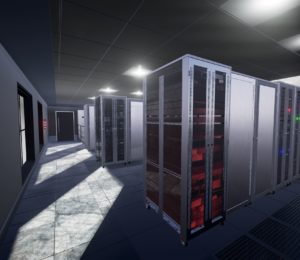
Charlie Koenig
Some people are passionate about architecture, some about visualization, and others virtual reality. Charlie Koenig is passionate about all three. Born and raised in Idaho, Charlie began experimenting with programs like AutoCAD in high school. His first experiences with softwares related to virtual reality came in the form of Autodesk’s 3ds Max with its VRML exporting format. This provided users with the ability to spin around inside a three-dimensional room or environment.
Charlie attended the University of Idaho where he began as an architecture student. The architecture curriculum already required students to learn 3D modeling. When Charlie found out about the University’s then new Virtual Technology and Design program he was excited. He soon changed majors. His knowledge of various modeling and design softwares made the transition easy.
After graduating Charlie went to work for Visual Genesis, a small firm that specialized in producing high-end computer graphics and animations for various fields. In 2008 Visual Genesis was acquired by POWER Engineers, a global consulting engineering firm specializing in the delivery of integrated solutions for energy, food and beverage, facilities, communications, environmental, and federal markets. Charlie now serves as POWER’s Sr. Visualization Specialist, AR/VR Lead.
and animations for various fields. In 2008 Visual Genesis was acquired by POWER Engineers, a global consulting engineering firm specializing in the delivery of integrated solutions for energy, food and beverage, facilities, communications, environmental, and federal markets. Charlie now serves as POWER’s Sr. Visualization Specialist, AR/VR Lead.
At POWER, Charlie works on a number of exciting and innovative projects. Charlie has worked extensively with cutting edge visualization tools that make complex transmission, generation and distribution projects easier to grasp. Charlie leads many of the transmission, distribution and substation photo simulation projects, typically created for regulatory agencies and the public. Visualization tools POWER uses are 3D animations, photo simulations and interactive applications. POWER is working to leverage the 3D content they create into VR/MR/AR technical applications; applications such as substation security analysis and safety training(VR), manufacturing plant process training(VR) and critical asset tracking using GIS (AR/MR). Below, Charlie answers a few questions about the industry.

Server Room Rendering
Q: Why are you passionate about VR?
Charlie: Virtual reality is exciting because it can be used for so many different purposes. In particular, it is a great tool for training. For example, putting people in situations that might be dangerous or expensive to recreate like a train wreck. In this case hazmat responders have to set up a train wreck scenario. Now they can do it in VR and could easily change the experience as they see fit. They can’t do that in real life.
Q: What do you think are the biggest challenges for businesses in this space?
Charlie: There are a limited selection of applications. In my industry there’s really nothing. If you go buy a vr unit, you don’t have a lot of great programs to choose from. Both consumers and businesses need access to more applications so they can see howvirtual and augmented reality technologies can be integrated into their business.

Powerline visualization
Q: What do you think the greatest opportunities are inside of the VR/AR space?
Charlie: Right now it’s really gaming. That industry is so powerful and it’s a huge driver in terms of the technology we are seeing. I think that more professional use opportunities will spring off the developments in the VR gaming industry.
Q: What do you think businesses need to keep in mind when entering this space?
Charlie: Leverage the technology. Currently the industry is very developer driven. We are seeing a lot of rough ideas of what can be done but not fully robust applications. There’s still a lot of education that needs to be done such as general education to consumers and businesses about what the technology and how it works.
We’re very excited to have Charlie on board with the IVRC as a Founding Member! If you’d like to connect with him, he can be reached via LinkedIn.


Recent Comments